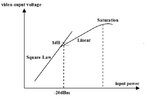elektr0
Full Member level 5

- Joined
- May 2, 2006
- Messages
- 279
- Helped
- 2
- Reputation
- 4
- Reaction score
- 3
- Trophy points
- 1,298
- Activity points
- 3,374
Hello,
sometimes the linear dynamic range of square law power detectors is defined between
the TSS power level (tangential signal sensitivity) and the 1dB compression point.
The books from Maas explain how the TSS value is measured.
The term "1dB compression point" is normally used for amplifiers and is defined for power levels.
Does anybody know how we can use this term in case of detectors (with DC voltage at the output and RF power at the input) ?
Thank you very much.
-e
sometimes the linear dynamic range of square law power detectors is defined between
the TSS power level (tangential signal sensitivity) and the 1dB compression point.
The books from Maas explain how the TSS value is measured.
The term "1dB compression point" is normally used for amplifiers and is defined for power levels.
Does anybody know how we can use this term in case of detectors (with DC voltage at the output and RF power at the input) ?
Thank you very much.
-e



